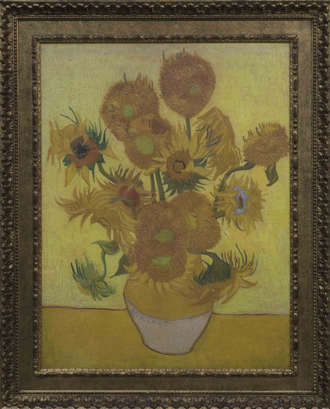3-D replicas of Van Goghs set to hit market

A copy of the Vincent Van Gogh painting “Sunflowers” (1889) is seen in this handout photo provided by the Van Gogh Museum.[REUTERS/NEWS1]
So far, five of the Dutch painter’s best-known works, including “Sunflowers” and “The Harvest,” have undergone the treatment in a project backed by Amsterdam’s Van Gogh Museum using technology developed by the Fujifilm unit of Fujifilm Holdings Corp.
“This is the next generation of reproductions. In the past we had lithographs, then photographs, first black and white, then color. Now these are reproductions in three dimensions,” Axel Rueger, director of the museum, said.
Each numbered copy on canvas with relief costs 25,000 euros ($33,300). The complex production process means only three can be produced a day, Rueger said.
That’s more than the usual $15 university dorm poster of “Sunflowers” but a lot less than the $82.5 million Japanese businessman Ryoei Saito paid in 1990 for Van Gogh’s “Portrait of Dr. Gachet” at a Christie’s auction.
The market is unlikely to feel any impact from the cheaper but technically proficient copies, one art expert said.
“I don’t see any harm done to rich Van Gogh collectors globally,” Jop Ubbens said. “It is a brilliant innovation from a merchandising perspective by the museum reaching out to a total new target group.”
Like many arts institutions hit by government budget cuts, the Van Gogh Museum is turning to the private sector and commercial ventures for funds. It hopes to raise tens of millions of euros by selling the three-dimensional reproductions, known as “Relievos.”
The original work is copied using Fujifilm’s Reliefography technique, which combines a three-dimensional scan of the painting with a high-resolution print.
A copy of the painting is first made on canvas, producing a colorless relief. Ink is applied so the brush strokes match those in the original. The image is framed and the same process is used to apply copies of the torn and splotchy official stamps stuck to the back of the frame and canvas.
Van Gogh’s paintings appear highly textured as he used a technique known as “impasto,” where the paint is applied thickly to the canvas, showing the brush or knife strokes.
“It’s reasonably difficult to see the difference between the copy and the original. Maybe the edges of the brush strokes are not quite so sharp on the copy and the overall sheen is fairly even, whereas on the original the varnish can vary,” Rueger said.
Reuters










with the Korea JoongAng Daily
To write comments, please log in to one of the accounts.
Standards Board Policy (0/250자)